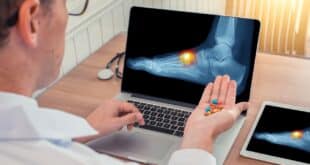But it can have some shortcomings if you want to achieve serious weight loss or cardiovascular fitness. These shortcomings were highlighted in a recent study from the Center of Disease Control and Prevention in Atlanta, Georgia. It showed that 94 percent of people who exercise mainly by walking do not walk frequently enough or fast enough to gain real health benefits.
Walking Posture and Technique Tips
- Look straight ahead, not down
- Stay upright, don’t lean forward
- Breathe deeply and steadily
- Pump your arms and bend your elbows at 90 degrees
- Keep your stomach and your buttocks tucked in
- Step onto your heel, then roll through onto the ball of your foot
- Push forward off the toes of your back foot
Following are ten important strategies to help you get the maximum benefits from your walking workouts.
1. Walk often
How often you should walk depends on your level of fitness and the duration of your walks.
For beginners: Aim for four to seven days a week. You need one to two months of regular walking to build a foundation of strength and fitness. (after that, see below.)
For weight loss: Walking is a low-impact, low-intensity exercise, so you need to do it regularly to get a result. Do your best to exercise every day, or at least every other day. Avoid missing walking two days in a row.
For Advanced walkers: Aim for three to five walks a week. Walk fast for 60 minutes, and incorporate different activities that challenge you into your program.
2. Walk fast
Speed matters. People who maintain a faster pace while walking will burn more calories and get better results. After a few weeks of regular walking, a leisurely stroll just won’t cut it.
If you can’t hear your breath while you walk, you’re not walking fast enough. For beginners and those hoping to lose weight, walk like you’re five minutes late or at a speed where you can hear yourself puff. Really gasping for breath should be left to the advanced walkers, who would benefit from regular bursts of very fast walking or running to get breathless. But giving a specific speed as a guide can be inaccurate, because it is harder for shorter people to walk at the same speed as taller people.
3. Walk long
While any exercise is better than none at all, unless you are a beginner, you will need to walk for more than ten minutes a day if you want life-changing, body shape-changing results. It’s also important to consider how often and how fast you walk when determining how long you should walk.
One good way to work out the ideal duration is from a seven-day perspective, where you can vary your duration based on your frequency. Every seven days, try to accumulate about four hours of walking.
For example:
4 x 60-minute walks per week;
5 x 50-minute walks per week;
6 x 40-minute walks per week; or
7 x 35-minute walks per week.
4. Include intervals (don’t slow down on the hills)
Many people walk at the same, steady pace, day after day.. I even see people avoiding hills on their walks or slowing to a crawling pace. But they are denying themselves the many benefits of interval training.
Little random bursts of effort at different intensities boost the calorie-burning, fat-burning, and fitness-increasing benefits of walking. For this reason, hills are a walker’s best friend. They help you increase the intensity of your walks without having to go fast or rely on running. Actively seek out hills and power up them.
Think positively about hills and view them as a shortcut to getting results. Another great way to add intensity without impact is to use flights of stairs, especially if you live in an area without any hills.
5. Swing your arms
Most people swing their arms, but it’s the more pronounced, purposeful swinging that helps burn those extra calories. Swinging your arms energetically can help you to burn up to 10 percent more calories while you walk.
Swinging your arms a little faster will also encourage your legs to come along for the ride, and it’s a good way to increase your pace. Keep your elbows bent to a 90-degree angle, keeping your shoulders down and relaxed.
Just don’t exaggerate your swing too much, or raise your arms too high, as it won’t propel you any faster and can stress your shoulders.
6. Add variety to your routine
There’s no doubt that variety is the spice of life, and the same rule applies to walking. If you stick to the same routine all the time, it’s only natural that you will get bored and find it harder to motivate yourself.
Try to vary the location, time of day, intensity, and duration of your walks to maintain interest. Look for ways to add variety to your walking routine.
Ways to Vary Your Routine
- Using different types of walking
- Training for an event or fun run
- Walking on different surfaces
- Inserting some interval training
- Trying cross training
- Walking on a treadmill
- Walking with a partner or pet
- Using gadgets, like a heart-rate monitor or pedometer
7. Measure your progress
As your walking improves, your legs will be stronger, you may weigh a little less, and your lungs will breathe a little easier. The fitter you get, the more efficient your body gets at moving you around. This also means you will burn fewer calories. So unless you continue to increase the duration, intensity, or frequency of your walks, your progress will grind to a halt.
Keep a record of any information you can, such as the distance you cover, your personal best time over a given course, the intensity of your walks, the total duration of your walks, or the total steps taken each day. Having times to beat or distances to cover also adds to your motivation.
8. Eat and drink well
Whether you are concerned about your weight control, fueling your walking program, or just maximizing your health and vitality, what you eat and drink will have a major impact on your results. Exercise is only half a picture.
Don’t focus just on walking, because if your diet is not up to par, you will struggle to enjoy the benefits walking has to offer. If you are going to invest the time and effort in an exercise program to burn off calories, don’t just add excess calories straight back into your body.
Fuel your walks with wholesome food that gives you energy and actually helps burn fat. At the same time, cut back on high-calorie, low-nutrient foods and drinks that clog your fat cells.
9. Walk before breakfast
If you are hungry, your body is craving food because its stored blood-sugar levels are running low. If you go for a stroll in the morning before breakfast, your blood sugars are low, and you are more likely to use stored fat as fuel. You don’t necessarily burn more calories, but you burn off a higher proportion of fat as fuel than when you walk after breakfast. The difference isn’t large, but if burning stored fat is your goal—it helps.
Research shows that in a fasted state, up to 50 percent more fat is used during cardiovascular exercise compared to people doing an identical amount of exercise shortly after eating.
10. Get stronger
As you get older, you naturally lose muscle tissue, which reduces your strength and energy levels, and this results in middle-age spread. Lifting weights can reverse this process—walking can’t. While it is a wonderful exercise, it does very little to strengthen your upper body and your abdominal core.
Lifting weights helps to protect muscle tissue when you reduce your calorie intake. It also boosts your metabolic rate and helps with weight and fat loss. The weight you lift can be your own body weight, dumbbells, barbells, pin-loaded weight machines, or even water. Adding weights to walking is a great addition to every walker’s health and fitness routine.
If you liked this, you may also enjoy It’s All About Movement | Why Walking Is the Most Underrated Form of Exercise
Reprinted with permission Signs of the Times, November 2006.
© 2002 - 2025, AnswersForMe.org. All rights reserved. Click here for content usage information. Answers for Me Support & encouragement for every-day life
Answers for Me Support & encouragement for every-day life



